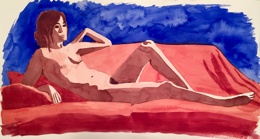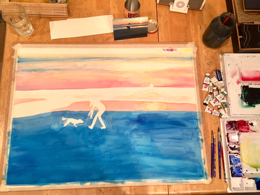Though I’ve been making art since I could hold a crayon, and have been a professional artist since 2011, I had never taken a watercolor class—until now. Next week will be my final session of a great sixteen-week class taught by esteemed artist Alan Sanborn.
Although the paint, brushes, paper and photorealistic approach are all different from my usual technique, I’ve gained so much from this class. I learned that to paint dark green trees, layering deep turquoise over orange can look more realistic than using green paint. Or how to use complementary colors for shadows: purple for a yellow banana or orange for a blue plate. Or even why it's worth spending $11 for a sheet of good watercolor paper!
Since a picture is worth a thousand words, I’ll share some examples of my assignments. And perhaps you’ll notice some evolution in my art over the coming months!
hovering brush
nothing and everything
in a pool of ink
64 shades of black: Our first major assignment was to cut a black and white photo into 64 tiny numbered rectangles, then reproduce it using a wide variety of blacks that we mixed.
Fishermen at dawn: We painted several 25-minute pieces in class, learning to make quick decisions about where and how to layer color.
Swan Lake: This was a study in layering color on an image with a black background, shown in progress.
And to think it only took 20 hours to transform a beautiful photo of a lily pond into a confusing jumble!
Languid lass: Our teacher had us paint the model in just two shades, light or dark, then add a few darker details. Surprising how realistic that can look.
The finished piece retains a subtle hint of the warm blue underlayer.
Playtime: Our final assignment: a self-portrait. This was the first of several layers.
Based on a photo by my son Gabriel, the finished painting depicts my dog Misha and me playing at the beach on New Year's Day.









